Ode to Marijke Ouëndag-Van LisHer energy, keen eye for the environment and her three children inspired her to design and make herself
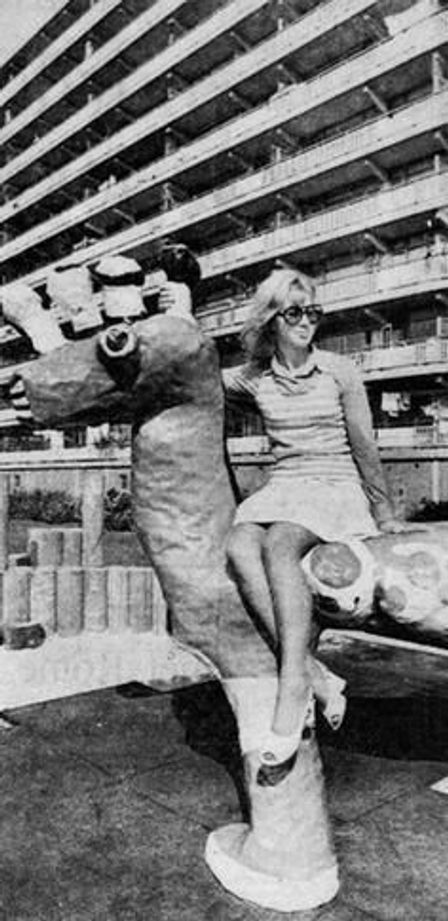
Marijke on woozel Molenwijk
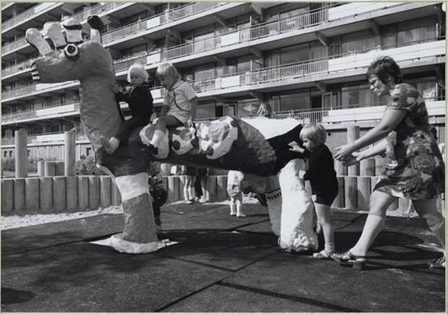
Children playing on a woozel in the Mill Molenwijk at the site of the Tjasker flat August 1972 Photo Service Archive
This text was translated using AI and may contain errors. If you have suggestions or comments, please contact us at info.ode@amsterdammuseum.nl.
Bored to death
The story of the wildebeests began in the book Winnie the Pooh by English author A.A. Milne. Wandering through the forest, Winnie discovered footsteps and cried out, ‘This is where wild
woozies running around." Then, sometime in 1970, the daughter of Marijke Ouëndag-Van Lis (1937) drew a fanciful animal and then mother Marijke thought: this is what I am going to make. And so the play objects, or woozels, created by Ouëndag-Van Lis were born.
The plan to make their own woozels arose from dissatisfaction about the few opportunities for development as a mother and frustration about the living environment with little attention for the child. Ouëndag-Van Lis had studied social psychology, married an architect and had children. That life was disappointing for her: ‘You discover that you live in an urban environment that is not designed for the child. That creates a huge tension for mother and child. You have to take care of any social contact for your children yourself, at least if you don't want them to crash in the streets."
Out of that thought, Ouëndag-Van Lis and her friends founded a preschool called Marijke. This became a huge success, much to the surprise of Ouëndag-Van Lis and her friends: ‘It went by storm and we were amazed at the huge employment potential among young mothers who are bored out of their minds in daily life.’ The preschool tasted like more, so Ouëndag-Van Lis turned to another part of child development: playgrounds and opportunities. According to Ouëndag-Van Lis, in the Netherlands these had
always had a residual function and were monotonous in nature, whereas in America she had seen wonderful examples among the big flats of New York.
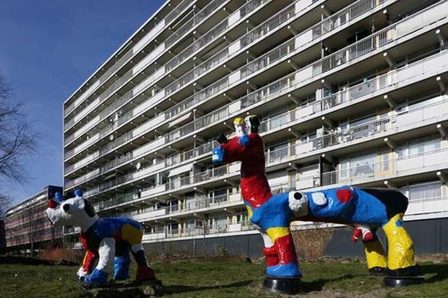
Woozels at Molenwijk 2018 Photo Edwin van Eis photobank municipality of Amsterdam 36067
A turbulent start
Inspired, Ouëndag-Van Lis set to work. The first woozel was created in the Delft living room, but did not yet suffice: the material was not strong enough. On this, Ouëndag-Van Lis decided to seek help from the industrial sector. This succeeded and she worked for months in a company that processed polyester. She explained about this period in an interview article with De
Time: ‘I shared the problems of those factory people and I discovered a completely different world. In the beginning, those men looked at me strangely, like: ‘What are you supposed to do with such a house-hut’. Indeed, at first I didn't know the difference between a nut and a screw, but those men didn't know how to bake a cake, so we were basically even and after a while I was accepted." The first indestructible wonks emerged soon after.

Woozles in the Amstelpark, September 1972. Source Archive of the Spatial Planning Department Image bank City Archive Amsterdam
Woozel flat at the 1972 Floriade
One of Ouëndag-Van Lis' first woozels was presented at the “Child and Environment” event, which was part of Amsterdam's Floriade in June 1972. In the large Expo Hall
near the Europa Boulevard, various films and photographs of children and their environment were exhibited, both indoors and outdoors. A creative workshop for
children, where drawing, painting and construction took place. Outside the hall, a market square had been created where, among other things, children could hop, climb or play with
sand. An eye-catcher in the square was Ouëndag- Van Lis' 5.5-metre-high and colourful woezelflat, a “totem pole-like construction” consisting of a slide and “arms” to which swings had been made by means of large balls. According to NRC Handelsblad, it was the woezelflat that ‘apparently rather baffled’ the young children of Princess Beatrix and Claus during the opening. The woezelflat became a success and earned creator Ouëndag-Van Lis commissions across the country. After the Floriade, alderman Han Lammers went in search of a site for the woezelflat, which was municipal property. In March 1973, a suitable spot was found: an empty lot in De Pijp on which the Sint Willibrorduskerk had been demolished shortly before.
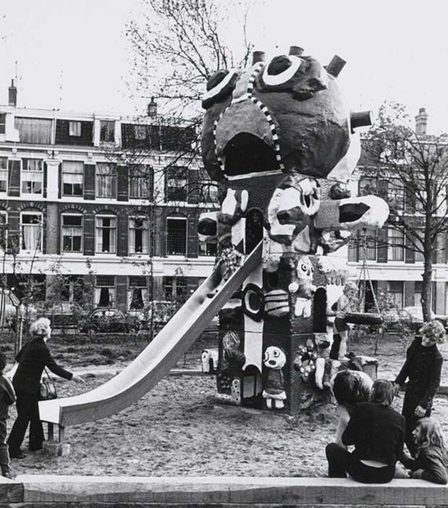
The Floriade's woozel flat was rebuilt in 1973 on the site of the demolished St Willibrordus church Date 19 May
Woozel family and children's tree
After Floriade, more and more woozel families appeared in the city. Commissioned by the municipality of Amsterdam, Ouëndag-Van Lis made a woezel family for the Molenwijk in Amsterdam-
Noord, a car-free neighbourhood in a park-like setting consisting only of flats. Belonging to this vole family are the 2 ospreys (1978) at Zaanhof in the Spaarndammer neighbourhood. Ouëndag-Van Lis also designed woozels for cities such as Voorburg and Zoetermeer. Most of them still function today.
A special woozel project was the children's tree in the Kalmoesstraat in Amsterdam-Noord from 1975, a play object designed by the Association of Businesses from
Amsterdam-Noord (VEBAN) as a gift. It was donated in connection with Amsterdam's 700th anniversary. Inspiration for the children's tree was an old Amsterdam
story that answers the question of where children come from. J. A. Groen jr. described this story in his book Rondom Volewijck en Tolhuistuin. A historical walk through
Amsterdam-Noord and its peripheral villages, also written and published in the context of Amsterdam's 700th anniversary. The play object on Kalmoesstraat was eventually destroyed by fire.
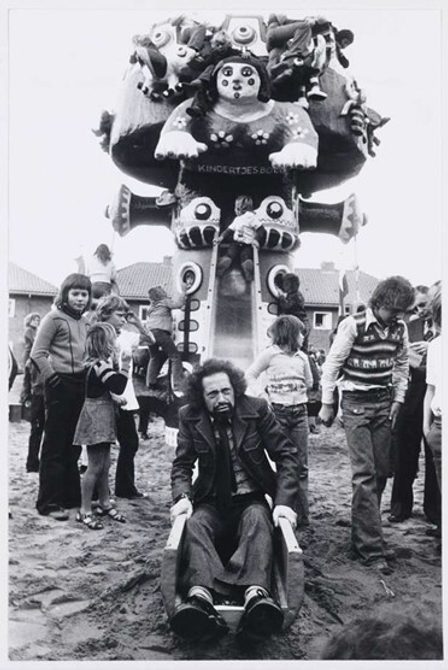
Alderman of Education and Youth Affairs Rudi van der Velde (CPN) inaugurated the play object at Kalmoesstraat Floraweg in Amsterdam-Noord on 4 October 1975. Photo ANEFO Collection Stadsarchief Amsterdam photos Beeldbank Amsterdam City Archive
A bleak environment
The success of the wonks made Ouëndag-Van Lis happy, but also critical. She herself spoke of ‘a one-eyed success in the land of the blind’. Rather, she did not see her woezels as
art objects. She did not consider art debatable, but something that was ‘immediately pushed into an elite corner’. Anyone seeing a woozel had to think they could make it themselves, according to the
philosophy of Ouëndag-Van Lis. Ouëndag-Van Lis herself had no training in art either and was a housewife, but her energy, keen eye for surroundings and her three children inspired her to design and make her own. She connected her designs to the living world of children, so they saw in her playparks a landmark on the playgrounds near residential buildings. With her colourful woollies, Ouëndag-Van Lis tried to make ‘the drab and metropolitan environment for children’ more playful and exciting. And that
task is one of all times.
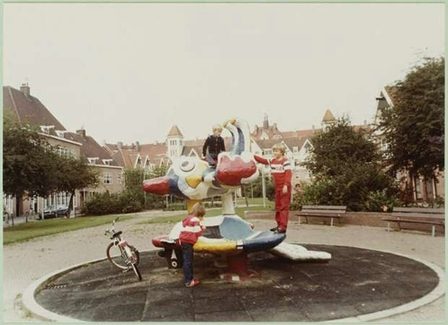
An adapted version of this ode previously appeared in the City of Amsterdam's Heritage of the Week section. Erfgoed van de Week | Woozels: imaginative play creatures
from the 1970s - Municipality of Amsterdam
About
Ode by Manon Fonteijn to Marijke Ouëndag-Van Lis
Marijke Ouëndag-Van Lis fought hard for children's play opportunities and art in public spaces in our city. She took the initiative out of her own dissatisfaction, was apprenticed to a factory with only men and her work still exists: I admire that perseverance.

Marijke Ouëndag-Van Lis
Marijke has championed play opportunities for our smallest residents and art in public spaces in Amsterdam. In the 1970s, she conceived, designed and made play objects for children of the city: colourful woozels.